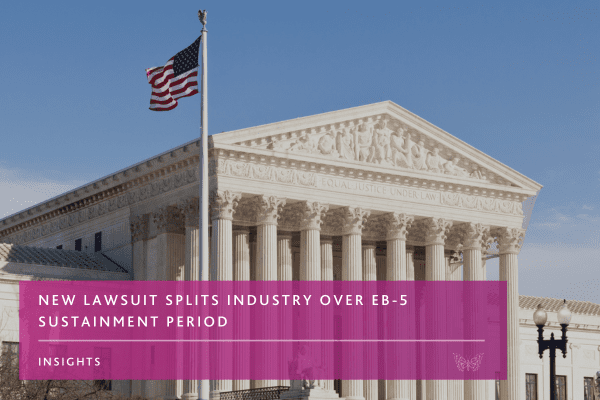A recent legal filing challenging the two-year sustainment period for EB-5 investments has drawn criticism from those who say it will do more harm than good.
In October, 2023, U.S. Citizenship and Immigration Services (USCIS) released guidance related to how it would be interpreting provisions in the EB-5 Reform and Integrity Act of 2022 (RIA). The aspect of the release that generated the most discussion within the industry was related to the minimum investment sustainment period.
Previously, EB-5 investors had to keep their investments “at risk” throughout their entire period of conditional residency. The RIA contained language that appeared to change this rule, and the USCIS guidance clarified that the minimum sustainment period would now be two years, meaning that post-RIA, investors “no longer need to sustain their investment throughout their conditional residence.”
This news was a relief for some investors, who no longer needed to worry about redeployment if their capital was returned before the end of their period of conditional residency. As Nima Korpivaara of KLD LLP explained at a JTC webinar, a slow USCIS adjudication process had previously “forced investors into longer and longer hold times,” which often resulted in their having to redeploy into “a second project that they’re not comfortable with.”
The panelists at our webinar largely agreed that the majority of EB-5 projects will still need to utilize investor funds for a 4-7 year timeline in order to fully deploy the funds and create the requisite jobs. Shorter investments may at first be attractive to investors who want their capital returned faster, but many of those projects will come with increased risk.
Ron Klasko, Chairman of Klasko Immigration Law Partners LLP, went into further detail on his blog about why “2 years does not mean 2 years” because of confusion over how the start and end date of the at-risk period would be calculated and whether it would be practical for an investor’s money to be returned before the project finished its lifecycle.
Klasko also notes his concern regarding “the quality of EB-5 projects that only need EB-5 money for 2 years,” as most large-scale EB-5 projects from reputable developers cannot be structured in a way that would accommodate two-year investments. “I fear that investors will be lured to riskier projects – – both financially riskier and riskier for EB-5 purposes – – while chasing the illusory goal of getting their money back in 2 years.”
One industry group sees what Klasko calls “a potential trap for investors” as not only dangerous for immigrant investors, but for the entire EB-5 program, and has taken a drastic step to address it.
What the IIUSA filing says about the sustainment period
On March 29th, 2024, industry trade association Invest In the USA (IIUSA) announced it had filed a federal lawsuit against USCIS, claiming “the agency failed to comply with the federal Administrative Procedures Act when it announced on its website a critical new rule that has the force of law without any opportunity for public notice and comment.”
While this seems like a largely procedural matter, IIUSA makes it clear that it is against the ruling itself, not just the way it was implemented, and also stresses “the purpose of this lawsuit is not to return to the previous sustainment policy that required many EB-5 investors to redeploy their capital for extended periods.”
According to IIUSA, USCIS “has the authority to interpret the relevant language in the EB-5 Reform and Integrity Act of 2022” – specifically the language that states the sustainment period be “not less than two years” – in “a range of reasonable ways that consider market realities, reliance interests, and other key factors. The agency is not limited to a binary choice between the previous status quo and the two-year guidance recently issued.”
To emphasize the fact that the goal of the lawsuit is not to return to the way things were, IIUSA also filed a petition for rulemaking that states “reducing the sustainment period to a two-year minimum will thwart the job-creating goals of the program and ultimately harm investors.”
IIUSA recommends USCIS “impose safeguards to ensure that investment is placed into high-quality projects, promoting job creation, encouraging economic growth, and best positioning investors to receive a return of their invested capital.” The petition notes that other federal economic development programs, including the New Markets Tax Credit and Opportunity Zones, have much longer holding periods.
IIUSA’s proposal is a five-year sustainment period that they believe would better protect investors while also eliminating the redeployment issues from when the sustainment period was the entire period of conditional residence.
There is little debate, if any, that USCIS violated proper procedure in issuing the guidance. What many in the industry take issue with is whether IIUSA’s lawsuit would actually lead to the proposed five-year sustainment period or if it will be a step backward.
Criticism of the lawsuit from within the industry
Upon the announcement of the lawsuit, many in the industry spoke out against it. Much of the criticism stems from the perception that IIUSA is advocating for a five-year sustainment period simply because that makes more sense for real estate developers, while investors would prefer the opportunity to get their capital back as quickly as possible. IIUSA’s push for five years may be out of a desire to protect investors from lofty promises of quick returns that can’t be kept, but some argue investors should not be prevented from pursuing projects promising the minimum sustainment period if they want to.
Suzanne Lazicki pointed out on her blog that while a five-year sustainment period currently lines up with USCIS processing times, this is not the optimal scenario. The law itself has mentioned “two years of conditional residence,” expressing an expectation that investors would only be in the queue for that long. But a two-year wait hasn’t been feasible for most investors because of long adjudication times.
“If established business models rely on an immigration process lasting much longer than two years,” says Lazicki, “then they depend on USCIS processing problems and visa EB-5 oversubscription.”
She adds that while long adjudication times have become the norm, “If the EB-5 process functioned as Congress intended, then the EB-5 investor could complete the immigration process within three years of the time of investment.”
There is also the issue of whether IIUSA’s lawsuit will actually accomplish its goal. The American Immigrant Investor Alliance (AIIA) has taken a stance against redeployment entirely, regardless of the time period, because the goal of EB-5 should be immigration and community impact, not sustaining an investment for an arbitrary number of years.
AIIA points out that if a court ruling invalidates the USCIS guidance on the two-year period, that doesn’t mean the proposed five-year period will automatically be instituted.
“The only result this lawsuit can possibly achieve in the short term is reverting to the practice of endless redeployments,” said AIIA. This would put things the way they were before the RIA, with the sustainment period tied to adjudication wait times, and some investors forced into indefinite redeployment thanks to slow USCIS processing.
How this may affect investors and Regional Centers
It is unclear at this point how this lawsuit will play out. The procedural element may have merit, but as critics have pointed out, that doesn’t necessarily mean a five-year sustainment period is what investors and other EB-5 stakeholders need.
Since the guidance was issued last October, a number of EB-5 petitioners have subscribed to offerings hoping that they will accommodate a sustainment period of two years. If the guidance is overruled, there could be a lot of disappointed petitioners out there who will now be forced to redeploy. It’s too early to tell how the anticipated two-year projects will fare: will there be a large number of petition denials based upon how the two-year period is calculated or fraud perpetrated against investors? Only time will tell.
It’s important to encourage investors to seek a project that will not only protect their invested funds, but also help them comply with current EB-5 requirements. That’s why JTC provides services to help immigrant investors know they’re invested in the right projects. As an escrow agent and administrator, we offer a banking solution that provides 100% FDIC insurance for investor funds and an enforceable co-signatory control. We also offer a 24/7 online portal with immigration workflow so investors can see the status of their funds at any time, from anywhere in the world, and access important documents and information they need for their visa applications.
When investors see a project is working with JTC, they know that the Regional Center behind it cares about helping them protect their investment and achieve their immigration goals.
Learn more about JTC’s services for Regional Centers and EB-5 investors.
Stay Connected
Stay up to date with expert insights, latest updates and exclusive content.
Discover more
Stay informed with JTC’s latest news, reports, thought leadership, and industry insights.
Let’s Bring Your Vision to Life
From 2,300 employee owners to 14,000+ clients, our journey is marked by stability and success.



















